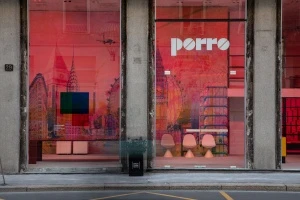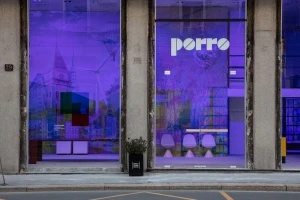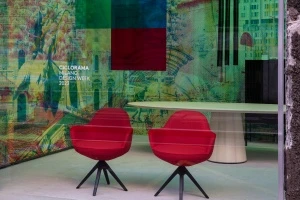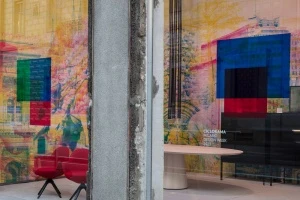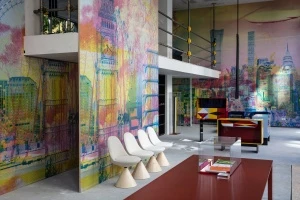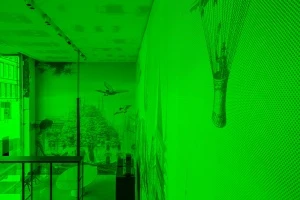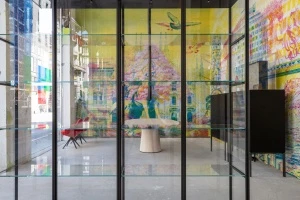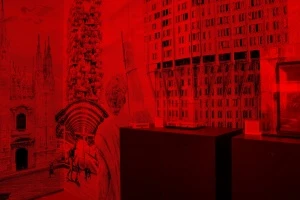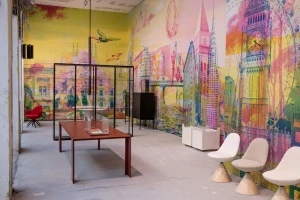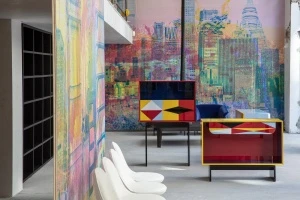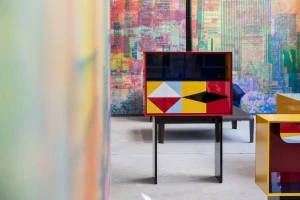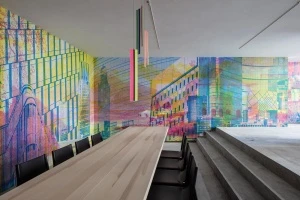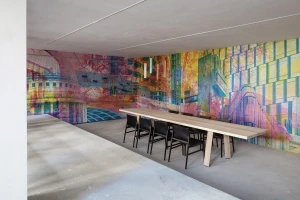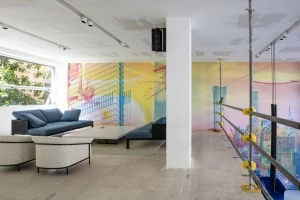18-23 April
With a temporary immersive three-color installation inspired by Bruno Munari research on color, and a narration that travels through time and space, Porro opened during the Milano Design Week the doors of the new Milanese showroom construction site: a multi-level interior full of design possibilities, where to express its architectural soul in unprecedented installations.
Architectural project + set up. Piero Lissoni.
Visual installation. Sfelab.
Bruno Munari’s works. Special thanks to Corraini Edizioni.
New products. Piero Lissoni, GamFratesi, Alessandro Mendini.
Drawing inspiration from Bruno Munari’s playful inventiveness, research on color, and the fascination of his children’s books, the special exhibition celebrated the temporary opening of the space during the FuoriSalone.
“Mix the drawings and change the colours of the eyes: let’s get used to looking at the world through the eyes of others” - wrote Bruno Munari.
This is why, in a building site that is still a work in progress, Piero Lissoni’s set up of the pieces that have marked the brand’s contemporary history interacts with an immersive three-colour installation created by Sfelab: a “cyclorama” evocatively surrounds the visitor with its landscape of juxtaposed colours and reveals its secret contents only to those who know how to “play” and wear a magical pair of paper glasses with colored jellies, which allow, by choosing the color, a different story to be read each time.
From the past in an early 20th century Brianza region, where the company was founded as a workshop specialised in the manufacture of wooden furniture – to underline the artisan soul and the still very strong bond with the local area and its network of relations with excellent manufacturers – to the present time in today’s cosmopolitan Milan, up to a future to be imagined, discovering one of the most successful brands on the contemporary scene.
At the entrance, the visitor is welcomed by a parade of Romby chairs, featuring a truncated cone base in solid natural ash and a compact seat upholstered in various fabrics and leathers from the Porro collection: designed by GamFratesi in 2020 and smoothly and slowly turned into the “manifesto” item of Porro design, the chair instantly conveys the typical geometric purity, manufacturing excellence and artisanal flavour of the brand.
Moving on are the 3 new incredible Linea storage units, designed in 2015 by Alessandro Mendini and manufactured in 2023 after a search in the Archivio Alessandro Mendini conducted by Maria and Lorenzo Porro together with the designer’s daughters, Fulvia and Elisa: solid parts with optical geometric motifs are juxtaposed with coloured empty spaces, testifying to the search for decorative richness and an emotional connection with objects. The Kite armchairs designed by GamFratesi in 2017 fit discreetly into the space with their plastic fan shape. They are gathered around Piero Lissoni's Ferro table from 1994, featuring a sensual curved line, rounded corners and wide-ranging joints. For the living area, the well-thought design of Ferro comes in the low table version, h.400 mm: a visual icon with a light look, perfect to be placed in the middle of a room for a sophisticated yet convivial atmosphere.
In the centre, the airy pace of Piero Lissoni + CRS Porro’s System from 1995 in black stained ash catches the eye, inviting to linger over the tactile and visual details of the woods of the Porro collection.
Highlighting the naturalness of materials and the beauty of imperfection, Piero Lissoni's Ryoba table comes with legs and top in thick solid olive ash wood. The triangular legs create a trestle supporting the textured tabletop, composed of solid wood boards all different from each other, carefully selected by the master cabinetmaker. The table’s size, which is narrow and long to respect the natural size of the logs, offers a new intimate conviviality, while the cracks that are left visible and the filled knots underline the poetry of this beautiful wood. Around it, the GamFratesi's Voyage chairs from 2016, featuring an exposed frame in solid turned maple and a leather upholstery that fits perfectly over the structure and gives shape to the backrest and the seat.
While going back, you are captured by the deep colour of Piero Lissoni's Metallico table from 2011, characterised by the lightness of its top and legs, made of 12 mm thick solid aluminium. The sophisticated detail of the joint between the leg and tabletop shows the strength of the technology used, which allows for rigorous lines and reduced thicknesses: a combination of extraordinary elegance. The special surface finish is obtained by means of a catalysed high-thickness varnish, followed by hand-sanding and waxing.
A must-have is Bruno Munari’s Cubovo from 2008. It can be used in the dining room as a food trolley, or in the bedroom as a capacious bedside table, thanks to its 4 drop-leaf compartments. Its design, reminiscent of the 1960s, makes it an unmissable piece for those who want an iconic object in their home, never prone to fads.
The last area is introduced by Piero Lissoni’s Ex-Libris from 2011, the showcase with a high-quality look and feel designed to store and display rich collections.
On display is the new Romby armchair by GamFratesi conceived for an all-round use, opening up new possibilities in the home office and contract sector. The shapes of the padded shell seem to blossom, widening and rising to create the armrests, releasing a new, unprecedented feeling of softness and naturalness, but still retaining the lightness and minimalism of the original model.
Vibrating in the space and capturing the eye for the delicate nuances of nature, the Materic Ovale table by Piero Lissoni from 2022 has an oval top and a truncated cone base both in solid Latte ash wood: a silent object epitomizing visual harmony, poetically minimal.
Craftsmanship is key also for Piero Lissoni's Offshore storage unit series from 2019, made of open-pore varnished ash wood and featuring an unusual opening style with a recessed handle: a metal-plated hole, to rediscover tactile sensations. Thanks to the special 45° connection between base, side panels and top – the result of an accurate manufacturing process – Offshore is perfectly finished on all sides and can be placed in the middle of the room.
A story of the company in an overlapping of layers travelling freely in time and space, also including a small exhibition dedicated to Master Bruno Munari created in collaboration with Corraini Edizioni.
From the lightshade glasses to the book Guardiamoci negli occhi, from the game Proiezioni Dirette to the works Polariscopio and Rotori, where experiments on light, color and movement are transformed into engaging interactive games: an evocative project to be discovered one step at a time, along with the visionary installations with which Porro has fascinated the world of design over the years, becoming an essential stop along the Milan Design Week route.
Works on display.
Bruno Munari, Proiezioni dirette, 1953, Danese Milano, box game, 30x30x4 cm.
Exhibited for the first time on October 13, 1953 at Studio B 24 in Milan, they were conceived as an experiment in deconstructing the principles of painting on canvas; critically acclaimed, they were exhibited twice at MoMA in New York in May 1954 and October 1955 alongside illegible books and design works. The work immediately presented an innovative character: the transposition of the concept of painting to a cinematic scale.
It was late 1959 when Bruno Munari exhibited the Proiezioni dirette at the Galleria Danese in Piazza San Fedele 2 in Milan. The invitation to the opening night on December 10 reported, "Spectators are also allowed," ironically remarking the participatory intent of Munari's project: an art by everyone and not just an art for everyone. A collective performance almost a decade before art invaded the public scene in Italy.
From that encounter came the Proiezioni dirette in Danese's Children's Editions.
Bruno Munari, Rotore, 1993, painted aluminum, 140x10x10 cm
Part of the kinetic art experiments of which Munari was one of the inventors, together with Calder: art for the first time is in function to an external intervention: a revolutionary act against traditional art usually to be enjoyed in its immobility.
Bruno Munari, Polariscopio, 1990, metal, various materials, electrical components, 50x50x15 cm
"Then I did some research with polarized light -with an object that I call a polariscope - two Polaroid strips oriented one at 90° to the other -so the colors that you see are always complementary. This is an object of dynamic art, kinetic art, that I made in the 1950s. I had prepared slide slides, on one side a Polaroid, on the other side the glass. The light beam intercepts it with a second Polaroid, I rotate it and the colors change. I showed this in Cambridge, to Mr. Land, the inventor of the Polaroid, who was impressed and said, "But this is the art of the Polaroid, we have to do something with it." Because, you see, Land had always seen it as a substitute for Nicholas's prisms, for microscopic exploration, whereby according to the thicknesses and textures of the materials the colors changed. But Land had never seen it from the aesthetic aspect."
The effect of Polaroid film becomes visible by placing colorless material between a sandwich of filters; specifically with the rotating movement of the one closest to the observer, a virtual movement of the composition created by the artist is created. Munari designs both projections with the rotation of the polarizing filter in front of the projector lens and lightboxes with and without a motor, named Polariscope by the artist.
Bruno Munari, Rotori, 1994, plasticized collage, 40x6 cm
They fit into the path begun in 1933: the search for works of art in motion with useless machines, hanging objects, where all the elements are in harmonious relationship with each other, by size, shape, weight and color.
Bruno Munari, Guardiamoci negli occhi, 2003 Corraini Edizioni (first edition Lucini 1970) 15x4x14 cm
Born in 1969 as a gift, such that the first edition in 250 copies never went on the market. The theme of "faces" so dear to Munari here becomes a game related to the eyes and the different possibilities of seeing: "...mix the drawings, change the colors of the eyes, let us get used to looking at the world with the eyes of others..." Bruno Munari with these words gives an indication of use of the 25 colored cards all with holes for the eyes.
Bruno Munari, Occhiali paraluce, Corraini Edizioni (project Bruno Munari 1953) 20,5x20,5 cm
A perfect example of Munari's inventiveness and simplicity. In 1954, Munari patented the "Occhiali paraluce," a pair of sunglasses made from a single sheet of folded and cut cardboard. He said he was inspired by the way people protect their eyes from the sun with their hands.

